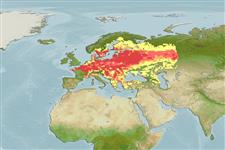Classification / Names
Common names from other countries
Main reference
Size / Weight / Age
Max length : 500 cm SL male/unsexed; (Ref. 59043); common length : 300 cm TL male/unsexed; (Ref. 9988); max. published weight: 306.0 kg (Ref. 9988); max. reported age: 80 years (Ref. 59043)
Length at first maturity
Lm 87.5, range 86 - 108 cm
Environment
Freshwater; brackish; benthopelagic; non-migratory; depth range 0 - 30 m (Ref. 9988)
Climate / Range
Temperate; 4°C - 20°C (Ref. 2059), preferred ?; 62°N - 36°N, 0°E - 80°E
Distribution
Europe and Asia. North, Baltic, Black, Caspian and Aral Sea basins, as far north as southern Sweden and Finland; Aegean Sea basin in Maritza and from Struma to Sperchios drainages; Turkey. Absent from the rest of Mediterranean basin. Now widely introduced and translocated throught Europe and Lake Balkhash basin in Kazakhstan. Several countries report adverse ecological impact after introduction. In Appendix III of the Bern Convention (protected fauna).
Countries | FAO areas | Ecosystems | Occurrences | Introductions
Short description
Dorsal
spines
(total): 1;
Dorsal
soft rays
(total): 4-5;
Anal
spines: 1;
Anal
soft rays: 83 - 95. Distinguished from all other freshwater fishes in Europe by the following unique characters: two pairs of mental barbels; and anal fin with 83-91½ rays. Differs further from the following combination of features: body naked; large, depressed head; dorsal fin with 2-4½ rays; caudal fin rounded or truncate; no adipose fin; and anal rays almost touching caudal (Ref. 59043). Caudal fin with 17 rays (Ref. 2196).
IUCN Red List Status (Ref. 115185)
Threat to humans
Potential pest
Human uses
Fisheries: commercial; aquaculture: commercial; gamefish: yes
Tools
Special reports
Download XML
Internet sources
Estimates of some properties based on models
Phylogenetic diversity index
PD50 = 0.5001 many relatives (e.g. carps) 0.5 - 2.0 few relatives (e.g. lungfishes)
Trophic Level
4.4 ±0.2 se; Based on diet studies.
Resilience
Low, minimum population doubling time 4.5 - 14 years (tm=3-4; tmax=30)
Vulnerability
Very high vulnerability (84 of 100)
Price category
